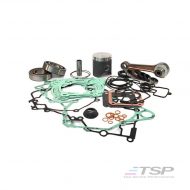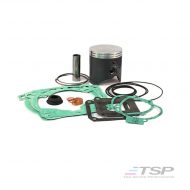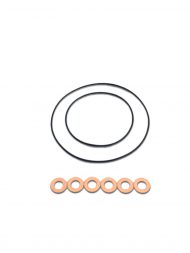Billet Heads FAQ
Billet Heads
For fitment instructions including technical specifications (squish clearances), please see our page here: https://www.twostrokeperformance.com.au/installation-instructions/
What compression ratio should I use?
When it comes to compression ratio less is often more! Each bike differs regarding the compression ratio that we recommend so please read the individual product listing pages to help decide which compression ratio you should choose for your bike.
Choosing an appropriate compression ratio for your elevation and conditions is critical… the right compression ratio will give great bottom end and midrange, rev out well up top and be super smooth with noticeably less vibration. Some bikes on the market come with very low compression ratios that can safely be raised to increase performance. Other bikes come with compression ratios that are already TOO HIGH and actually make more power everywhere when a lower compression ratio is used… this is counter intuitive to many people but trust us, less is often more!
Generally all heads made by TSP come with a slightly lower compression ratio than many other aftermarket brands… even our “High” comp heads are often less than other brands mid comp heads. After many years of machining heads and setting up bikes for thousands of customers all around the world (including world and national champions) we have learned what works and what doesn’t and based on the overall feedback from our customers we design our heads like this for a very good reason. We are also continually testing and developing our designs in the search for greater performance and smoothness.
Many brands of aftermarket heads use overly high compression ratios to boost bottom end and midrange power as much as possible. High compression ratios (for the given altitude) usually make great power just off idle but then they run flat up top and vibrate more. They also overheat faster (which causes a loss of power), require richer jetting and the jetting is also much harder to dial in. The overall riding experience is not nearly as nice as a lower comp head with crisp jetting. Yes you may have slightly less power just off idle but overall the bike is FAR nicer to ride and more reliable.
If you want the best of both worlds then we can also add some ignition changes to get the ultimate spread of power… by matching the ignition curve to a suitable compression ratio head we can usually match the bottom end and midrange output of the competitors “High” comp head but then also maintain the free revving top end and the smoother power delivery characteristics of the lower comp head. Check out our info on Ignitions to see if we offer an ignition package for your bike.
What fuel should I use?
All of our products are tested using pump 98 RON fuel. This is the equivalent of 91-92 AKI in the USA and other regions.
What performance gains do your heads offer?
- More power
- Smoother power delivery
- More detonation resistance
- Better fuel economy
What squish clearance will your heads give?
It varies for each make and model as they all have different needs. In almost every case the squish clearance our heads give will be much tighter than stock. For example most 250/300 heads will have a squish clearance of approx. 2mm from the factory and our heads will give approx. 1.2mm depending on the model. Likewise 85 and 125 models will often come from the factory with around 1-1.2mm squish and we will run a tighter measurement around 0.85-0.90mm.
What compression ratio will your heads give?
We don’t disclose the specifics of each design however the descriptive terms we use for each head (Low, Medium, High, etc) relate to our opinion on how far they push the limits of normal 98 RON pump fuel at sea level for each corresponding model. Generally Low compression will be very safe and High compression will be as high as we feel is suitable for 98 RON fuel at sea level. In some cases our High comp heads are actually LOWER compression than the stock designs.
In many cases our heads give lower compression than many other aftermarket heads, but will usually give tighter squish clearance and higher squish velocity… our main tuning theory is that lower compression with tighter squish clearance will usually give the smoothest power delivery and the best spread of power, especially when combined with a suitable ignition curve.
What is squish clearance?
Squish clearance is the distance between the top of the piston and the squish band on the cylinder head, measured when the piston is at Top Dead Centre. It is always measured on the outer edge of the squish band around the bore wall.
Squish measurement is critical to combustion as it has a huge influence over the speed of the moving gasses as the piston approaches TDC, as well as the amount of turbulence generated.
The science behind squish clearance is complex however in basic terms having a tighter squish clearance usually allows more of the available fuel/air to be burnt more quickly. The exact result also relies heavily on having the correct match of combustion chamber design, fuel, ignition curve and pipe.
How do I measure squish clearance?
See the video on our website in the installation instruction section.
Imperfections on heads?
Occasionally there will be imperfections visible on our billet heads. Before packing we inspect every head for quality and from time to time we will find issues, damage or imperfections. Generally if the issue is small, is located in an area that wont be too visible when installed and wont cause reliability issues then we will allow the head to pass through inspection and consider it suitable for sale. Examples of these small issues may include:
- Very minor scratches
- Variations in anodising colour
- Very minor chips or dents in areas that are not critical for sealing coolant or combustion pressure
If you feel that the product you have received does not meet our normal high standards then please contact us via email BEFORE installation and include clear photos of the issue.
 ITEMS ORDERED IN STOCK ARE SENT EVERY DAY 12PM. Orders placed before 9AM go the same-day!
ITEMS ORDERED IN STOCK ARE SENT EVERY DAY 12PM. Orders placed before 9AM go the same-day! 







